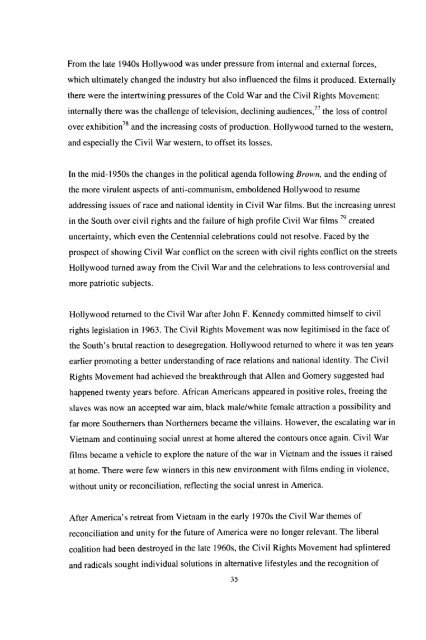Download (3483kB) - Greenwich Academic Literature Archive ...
Download (3483kB) - Greenwich Academic Literature Archive ...
Download (3483kB) - Greenwich Academic Literature Archive ...
- No tags were found...
Create successful ePaper yourself
Turn your PDF publications into a flip-book with our unique Google optimized e-Paper software.
From the late 1940s Hollywood was under pressure from internal and external forces,which ultimately changed the industry but also influenced the films it produced. Externallythere were the intertwining pressures of the Cold War and the Civil Rights Movement:internally there was the challenge of television, declining audiences, 77 the loss of control*7Sover exhibition and the increasing costs of production. Hollywood turned to the western,and especially the Civil War western, to offset its losses.In the mid-1950s the changes in the political agenda following Brown, and the ending ofthe more virulent aspects of anti-communism, emboldened Hollywood to resumeaddressing issues of race and national identity in Civil War films. But the increasing unrestin the South over civil rights and the failure of high profile Civil War films 79 createduncertainty, which even the Centennial celebrations could not resolve. Faced by theprospect of showing Civil War conflict on the screen with civil rights conflict on the streetsHollywood turned away from the Civil War and the celebrations to less controversial andmore patriotic subjects.Hollywood returned to the Civil War after John F. Kennedy committed himself to civilrights legislation in 1963. The Civil Rights Movement was now legitimised in the face ofthe South's brutal reaction to desegregation. Hollywood returned to where it was ten yearsearlier promoting a better understanding of race relations and national identity. The CivilRights Movement had achieved the breakthrough that Alien and Gomery suggested hadhappened twenty years before. African Americans appeared in positive roles, freeing theslaves was now an accepted war aim, black male/white female attraction a possibility andfar more Southerners than Northerners became the villains. However, the escalating war inVietnam and continuing social unrest at home altered the contours once again. Civil Warfilms became a vehicle to explore the nature of the war in Vietnam and the issues it raisedat home. There were few winners in this new environment with films ending in violence,without unity or reconciliation, reflecting the social unrest in America.After America's retreat from Vietnam in the early 1970s the Civil War themes ofreconciliation and unity for the future of America were no longer relevant. The liberalcoalition had been destroyed in the late 1960s, the Civil Rights Movement had splinteredand radicals sought individual solutions in alternative lifestyles and the recognition of35
















